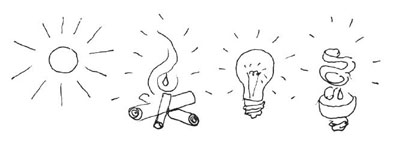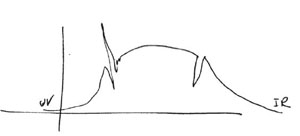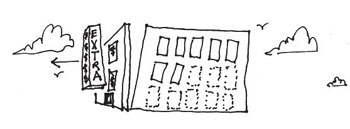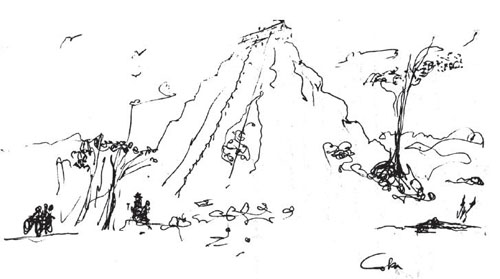Let There Be Light

Our hunter/gatherer ancestors spent most days outside. Evolution made their keenest vision in blue sky daylight. For eons, at sunset or around a fire, a red/orange glow signaled time for rest.
Understanding of our ancient responses is leading bulb manufacturers to strive toward lighting spaces for desired effect-alertness (office-most of the time) or relaxation (home-most of the time). Light bulbs, once a simple glowing filament in a pear sized clear sphere have morphed into a poorly understood cornucopia of sources and spectrums. Scientific American and Science News suggest that our brains are tuned to very specific frequencies of light to wake up and be alert-- the color of blue sky, toward cerulean. One of the few independent reviewers of these products and their health effects is the RPI Lighting Lab (www.lrc.rpi.edu/programs/lightHealth/index.asp). They have found some startling information about sleep cycles, alertness and yellow light cancelling the benefits of bluish light that may be related to health problems and cataracts in our aging population.

First, some background. . . . Ubiquitous “cool white” fluorescents enabled offices to become enormous, even underground, because room size was no longer tied to perimeter windows. These windows also lighted hallways thru patterned obscure glass, a look we find nostalgic in old detective movies. After improvements in color balance, so-called “full spectrum” (overpriced?), fluorescent lamps are advertised to help us see colors more accurately--as if we are in some version of daylight-- blue north light, sunlight or lilac overcast sky. Success of these products requires that they produce an even spectrum curve—like the sky. Some claim to be within 95% of accurate replication of daylight, tho’ 85% is more common. At first glance one is temped to conclude that we have an almost a perfect replica of daylight. However, consider that it is at least 5-15% off plus the spikes and valleys in the curve show that some colors are dull and others unnaturally vibrant. My personal favorite is the OTT light for artwork.
One European company is making light fixtures (not yet available in the US?) that shift from bluish in the morning to reddish in the afternoon, following the shift in the natural sky. Our hunter/gather ancestors might have felt right at home! Although I have seen no science, some folks have a concern about the subliminal rapid flicker of all fluorescent sources (televisions and computer screens). Whether artificial ultra-violet light is good for humans is simply unknown to me at this point.
A few decades ago miniaturization produced smaller, hotter lamps that gave us dazzling white light. Smaller fixtures could be aimed and shielded more easily, yet often had unwanted glare. More recently some light emitting diodes (LED) can provide precise color at a fraction of energy use (and a much higher fixture cost).
Alas, ghoulish mercury/sodium/metal halide vapor lamps replaced Edward Hopper’s lovely incandescent streetlights with their sensuous porcelain reflectors. Now streets have become many times brighter since their poles were put up years ago when weak incandescent bulbs could only spread their feeble light a short distance vs. today's blindingly bright metal halide lamps . It is possible that accidents and crime have been reduced (or relocated) but it is certain that we are wasting huge quantities of precious electricity. I will know that our country is serious about saving energy when the street and highway lights are turned off around midnight or not used on most interstate highways.
In our neighborhood, electric rates are jumping 50% this year, so it’s time to reconsider the compact fluorescent (and old appliances). Precise spectrum information for the most readily available lamps is mighty hard to find.
Final thoughts . . . There’s no substitute for full scale mockups-- sample bulbs in the space that you want to use them. Your own opinion of light that is pleasing for the task at hand-reading, drawing, sewing, painting or cooking is a pretty good guide.
Thanks to Mark Loeffler IALD of atelier ten for sharing some of his reading on this delightful subject. As always, I welcome any comments or corrections from my faithful readers.
The amount of light, its spectral composition, spatial distribution,
timing and duration needed for vision is so different from that
needed for circadian functioning, that generalizations about
’good lighting’ will have to be assessed by two very different
sets of criteria in the future.
— “Light - Much More Than Vision” Mark Rhea
EPRI/LRO 5th International Lighting Symposium Palo Alto CA.
BRIGHT NEWS & VIEWS

+ - I am organizing and moderating a program Old Buildings vs. Tough Budgets #4 -- three case studies: 1959 religious building & school, 1923 theater converted into a school and updating a Craftsman/Colonial Revival Bungalow 3-6 PM February 8 (snow date February 15th). See www. aiact.org website or call 865-2195 for more info.
+ - Helped folks think about buying a handsome Greek Revival house in Essex.
+ - Since 2002, a New Haven family has been patiently hiring excellent contractors to update their Colonial Revival Home. In addition to deferred maintenance and solving chronic leaks we are about to replace dysfunctional replacement windows. All have been working from my prioritized list & project specs subject of periodic review & new discoveries.
+ - Pleased to be on the building committee for a new daycare center.
+ - A wood working shop & storage building are under construction for Waterford folks.
+ - Considered for the restoration the Oxford Historical Society’s relocated 18th C house, challenging repairs to Torrington Historical Society’s Charles Allen “French/Victorian”
BRIGHT SPOTS

The wonders of Mexico’s Yucatan area-amazing divine subterranean pools open to the sky, Mayan pyramids reclaimed from the jungle, tiny towns with delightful improvisations and weathered walls plus the handsome colonial center of the modern city Merida (pop. one million), powdery sand and turquoise water, good food and the delightful Hacienda Chichen that once grew sisal, then cows and now farms folks like us. My theory about the pyramids in this vast flat landscape is that they were a place to get above the dense jungle and communicate with the sky and related deities. One of our big thrills was seeing tops of other pyramids 30 & 60 miles away
